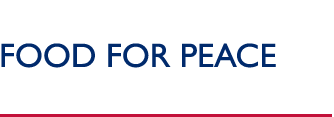What is Food for Peace?
“Food is strength, and food is peace, and food is freedom, and food is a helping hand to people around the world whose good will and friendship we want.” — Then-Senator John F. Kennedy in a 1960 speech in South Dakota, a few weeks before he was elected president.
 |
For more than 50 years, the Food for Peace program has brought hope and nourishment to the hungry corners of the world. Approximately 3 billion people in 150 countries have benefited directly from our food. The secret of Food for Peace's success lies in the unique combination of American compassion together with the unmatched efficiency of our nation's farmers. It is less a triumph of government than of working Americans, for in its essence, Food for Peace is the work of farmers, businessmen, grain elevator operators, truckers, bargemen, freight forwarders, port operations, private voluntary organizations, and government officials. Together they form an unbroken chain of humanity stretching from this country's fertile fields to hungry families half a world away. In the end, hope is what America has promised, and hope is what Food for Peace delivers around the world every day.
Upon reaching its destination, the food is used in a variety of ways, and always for the people most vulnerable to the effects of hunger: children under age 5, pregnant women, the elderly, and the poorest families in a community. During an emergency in which people face threat of imminent starvation, food - wheat, sorghum, corn and other commodities are distributed to save their lives. If the symptoms of extreme malnutrition have already appeared, a nutritionally fortified ration with blended, fortified, and processed food is provided. In less dire circumstances, food can be used to compensate people for work, such as building roads or repairing water and irrigation systems. In turn, these projects help protect communities from future hunger by providing them access to local markets for their produce, keeping them healthy, and improving their harvests.
Other methods of using food aid include:
- Working with farmers to identify better ways to sow and tend their fields or providing improved seed, thus improving their harvest by linking them with American knowhow
- Improving women's education about nutrition, resulting in healthier babies and children
- Encouraging the production of higher value commodities that could earn money in local markets
- Providing micronutrients, such as vitamin A, iodine, zinc, and iron, that hungry children often lack
- Feeding children at school to encourage attendance and improve academic performance
Though there are many ways of providing food aid, Food for Peace's goal remains constant: to minimize hunger in the world so that people everywhere can enjoy active and productive lives and, ultimately, to ensure that one day no one needs food aid.
Back to Top ^
|




